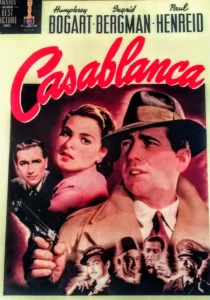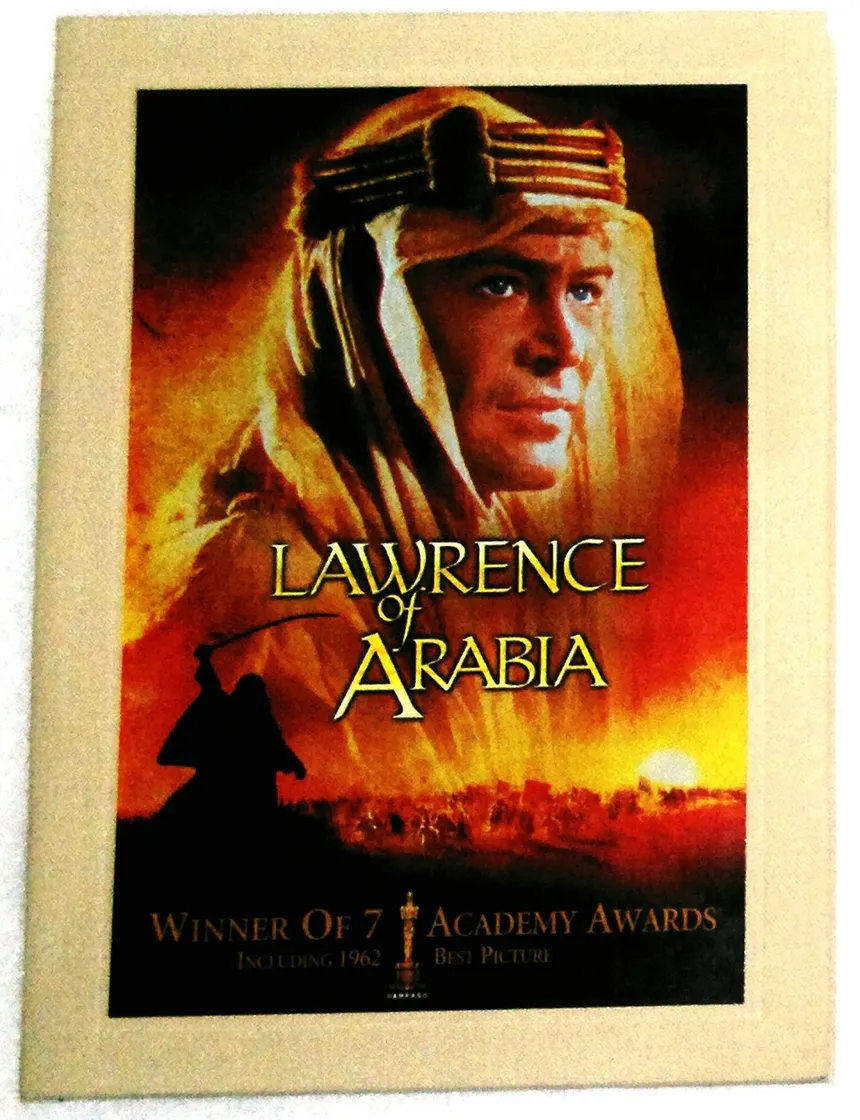
Lawrence of Arabia is a cinematic event and an enduring epic that premiered in 1962. It tells the story of T.E. Lawrence, a British officer who played a complex role in the Arab Revolt during World War I.
The film is a deep character study of a man wrestling with identity, morality, and empire. It delves into the complexity of a man torn between cultures, consumed by glory, and ultimately left hollow by the very legend he helped construct.
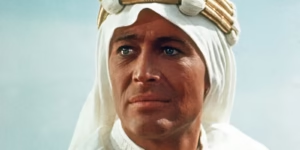
While based on Lawrence’s autobiographical account “Seven Pillars of Wisdom,” the film also explores his inner struggles and the broader themes of identity and empire, often moving beyond a straightforward historical account.
T.E. Lawrence was a British intelligence officer and archaeologist who is considered to have given a major stimulus to the Arab Revolt during the First World War. In the film, he is portrayed by Peter O’Toole in his first major screen role, which turned him into an international star.

O’Toole’s performance is considered one of the greatest in film history, capturing Lawrence’s enigmatic nature, internal contradictions, vulnerability, arrogance, charm, and torment. The film presents Lawrence as a man who defies categorization – a potential savior or a manipulator, a bridge between worlds or an imperial tool – leaving his true nature ambiguous.
STORY
Lawrence of Arabia (1962) begins with the fatal motorcycle crash of T.E. Lawrence in England, which frames the subsequent flashback of his life. In 1917, Lawrence, a young and unconventional British intelligence officer in Cairo, is sent to Arabia to assess the Arab Revolt against the Turks and to liaise with Prince Feisal. He earns the trust of Feisal and persuades him to wage a guerrilla war.
Lawrence leads a small group across the treacherous Nefud Desert and orchestrates the improbable capture of the strategic port of Aqaba from the land. This victory elevates his status among the Arabs, who begin to see him as a messianic figure, and he adopts Arab dress and customs.
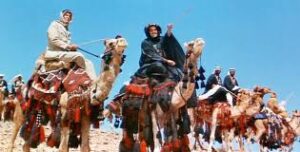
However, his experiences, including a brutal capture and torture in Deraa, begin to take a psychological toll, revealing a darker side to his nature and shaking his idealism.
Returning to Cairo, Lawrence becomes aware of the British and French imperialistic designs on Arabia, as outlined in the Sykes-Picot Agreement, which betray the Arab aspirations for independence. Despite his disillusionment, he is persuaded to lead the Arab forces to capture Damascus. However, the dream of a unified Arab nation quickly collapses due to tribal infighting.
Lawrence, broken and realizing the futility of his efforts and his manipulation by the British, departs Arabia, leaving behind the legend he unwillingly created. The film concludes with his departure, highlighting his isolation and the unfulfilled promises of the Arab Revolt.
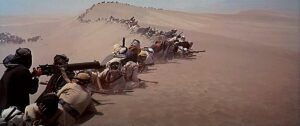
TECHNICAL DETAILS
The film was directed by David Lean, who was already a master of scale and subtlety. His direction is considered majestic, achieving a synthesis of spectacle and introspection. Lean transforms the desert into a character itself, with every shot and photographic appearance responding to the inner relations of the story. He masterfully uses wide shots to emphasize Lawrence’s isolation and insignificance against the grand desert, while also depicting him as the focal point of massive gatherings.
The match cut from Lawrence blowing out a match to the sunrise over the desert is one of the most famous edits in cinematic history, capturing the dreamlike transition from mundane reality to mythic journey.

While based on real events drawn from Lawrence’s memoir, the film takes considerable liberties with historical facts and the politics of the Arab Revolt. It streamlines events, omits others, and shapes a more dramatic arc to Lawrence’s transformation.
The film has been criticized for oversimplifying or mythologizing events and for its portrayal of Arab characters through a Western gaze. The casting of Western actors like Alec Guinness and Anthony Quinn in Arab roles is also noted as outdated by modern standards. However, the film does attempt, especially for its time, to give dignity and complexity to its Arab characters and critiques imperial ambitions.
Freddie Young’s cinematography in Super Panavision 70 is considered breathtaking, capturing the vast desert landscapes with painterly precision. The widescreen format allowed for shots of staggering beauty and scale, making the desert a character itself.
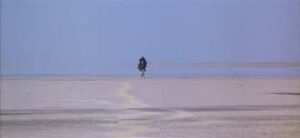
Maurice Jarre’s musical score is equally iconic, with its sweeping orchestral themes evoking both awe and melancholy, giving emotional voice to the characters’ unspoken feelings.
The film explores several key themes:
- Identity and Transformation: Lawrence attempts to shed his English identity by adopting Arab dress and customs but never fully belongs, leading to an “identity crisis” and internal split. His transformation is both physical and psychological, with his Arab robes symbolizing his alienation.
- Imperialism and Betrayal: The film critiques British imperialism, depicting officials as calculating strategists who use the Arab Revolt for their own strategic gains, ultimately betraying the Arab desire for unity.
- Violence and Glory: The film grapples with the dehumanizing consequences of war, tracing Lawrence’s gradual loss of innocence and his disturbing enjoyment of violence, questioning conventional notions of heroism.
- Mythmaking and Legend: The film examines how legends are constructed, with Lawrence becoming a symbol manipulated by media and governments, revealing the chasm between the man and the myth.
Awards
Lawrence of Arabia was a major award-winning film, receiving seven Academy Awards, including Best Picture, Best Director, and Best Cinematography.
It has left an indelible mark on cinema, influencing generations of filmmakers like Spielberg and Nolan, and its use of landscape, sound, and scale has become a blueprint for epic storytelling.
The film is considered a timeless and relevant work that resists easy categorization, challenging viewers to confront uncomfortable questions about identity, power, and heroism.
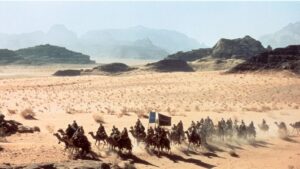
Highlights
- The film was a large and ambitious project, taking around three years to make with significant logistical challenges.
- The opening of the film includes a jaunty British march prologue to a black screen for about 5 minutes.
- The custom-made motorcycle Lawrence rides in the beginning was a ‘George VII’ Brough Superior.
- Director David Lean makes a brief cameo in the film as a motorcyclist near the Suez Canal.
- The film’s initial running time was 222 minutes but was subsequently cut down before being restored later.
- The film notably has virtually no female speaking roles.
- Peter O’Toole was a virtually unknown actor in his first starring role when he was cast as Lawrence.
Stay with Thiraimozhi News paper and website: https://thiraimozhinews.com/and Thiraimozhi talkies https://www.youtube.com/@Thiraimozhi_Talkies for videos
To buy book in Amazon: https://amzn.in/d/5vmxIPI
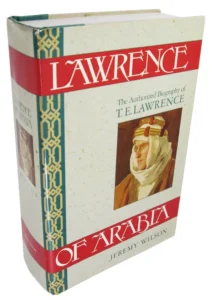
To watch the movie in Netflix: https://www.netflix.com/in/title/70012020
Movie Trailer:

